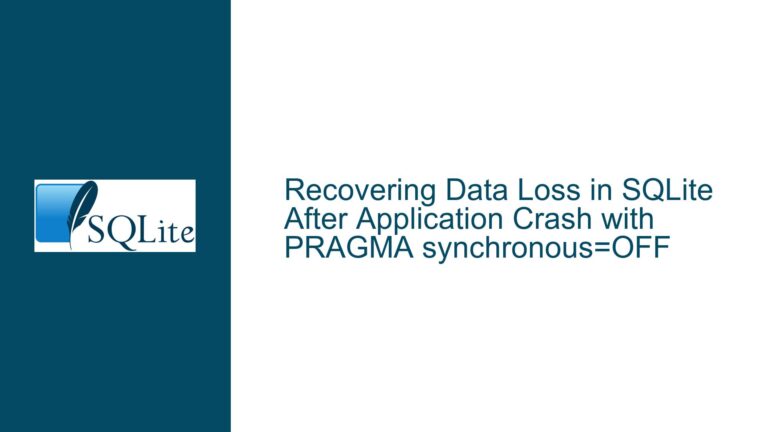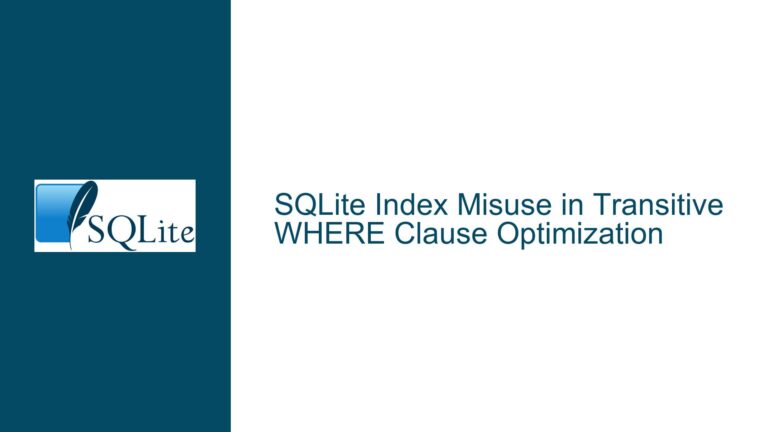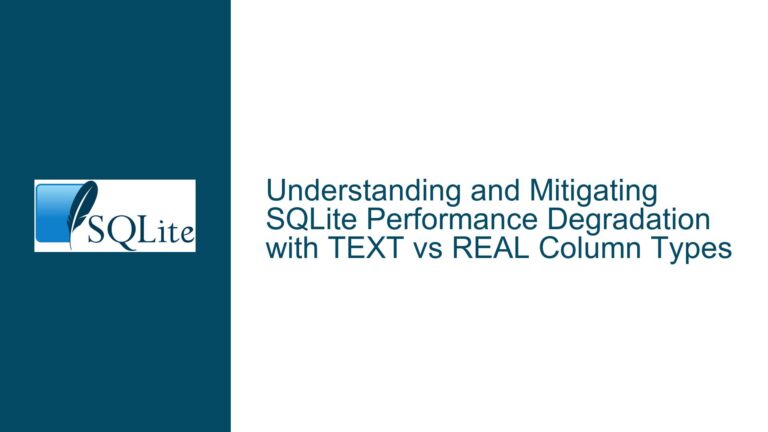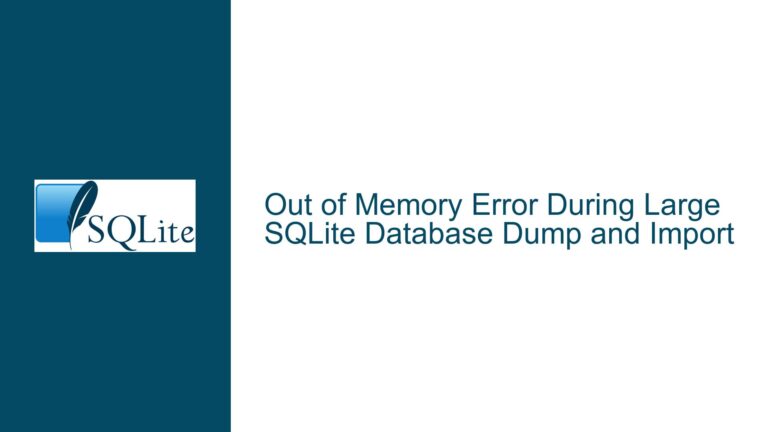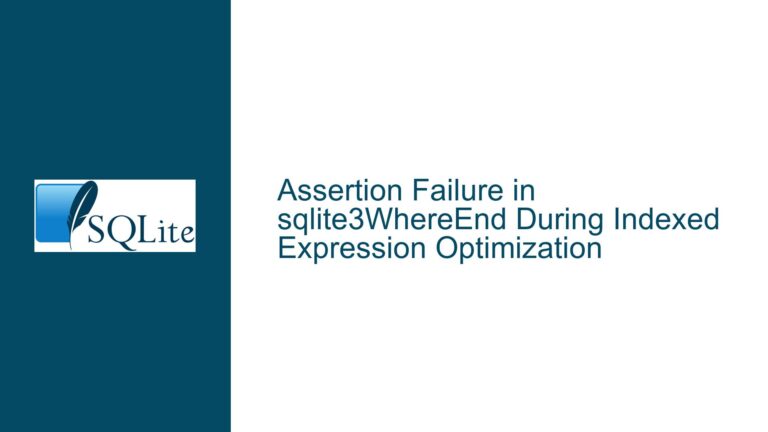Insert Time Spikes in SQLite WAL Mode After Resetting mxFrame
Insert Time Spikes During WAL Log Reset in SQLite
When using SQLite in Write-Ahead Logging (WAL) mode, one of the most critical performance metrics is the consistency of insert times. However, under certain conditions, insert operations can experience significant time spikes, jumping from a baseline of 0.1-0.2 milliseconds to as high as 4 milliseconds. This issue is particularly pronounced when the mxFrame value in the WAL log is reset to 0 during the walRestartLog operation. Understanding the root cause of these spikes and how to mitigate them requires a deep dive into SQLite’s WAL implementation, the role of mxFrame, and the interplay between various PRAGMA settings.
The mxFrame value in SQLite’s WAL mode represents the highest frame index in the WAL file that has been committed. When the WAL log is reset, mxFrame is set to 0, effectively starting a new log. This operation is typically triggered during a checkpoint or when the WAL file reaches a certain size. While this reset is necessary for maintaining the integrity and performance of the database, it can inadvertently cause insert time spikes, especially in high-throughput environments where write operations are frequent and time-sensitive.
The issue is exacerbated when autocheckpointing is disabled, and checkpointing is manually managed using SQLITE_CHECKPOINT_PASSIVE. In such configurations, the database relies on the application to initiate checkpoints, which can lead to situations where the WAL file grows larger than optimal, increasing the likelihood of mxFrame resets and the associated performance hits. Additionally, the specific PRAGMA settings, such as journal_mode, synchronous, and cache_size, play a significant role in determining how the database handles these resets and the overall impact on insert performance.
WAL Log Reset and mxFrame Impact on Insert Performance
The primary cause of insert time spikes during mxFrame resets lies in the way SQLite manages the WAL file and its associated metadata. When mxFrame is reset to 0, SQLite must perform several internal operations to ensure that the new log is correctly initialized and that all pending transactions are properly accounted for. These operations include updating the WAL index, flushing the WAL file to disk, and ensuring that all changes are synchronized with the main database file. While these steps are necessary for maintaining data integrity, they can introduce latency, especially if the WAL file is large or if the system is under heavy load.
Another contributing factor is the interaction between the WAL mode and the synchronous PRAGMA setting. When synchronous is set to NORMAL, SQLite does not immediately flush every change to disk, which can improve performance under normal conditions. However, during a mxFrame reset, the database must ensure that all changes are safely written to disk before proceeding. This can lead to a temporary increase in write latency, particularly if the system’s I/O subsystem is already under stress.
The cache_size PRAGMA setting also plays a role in this issue. A larger cache size can help mitigate the impact of mxFrame resets by reducing the frequency of disk I/O operations. However, if the cache is too large, it can lead to increased memory usage and potential contention with other processes, which can further exacerbate the problem. Additionally, the busy_timeout setting, which determines how long SQLite will wait for a lock before returning an error, can influence the severity of insert time spikes. A longer busy_timeout can help reduce contention but may also lead to longer delays if the system is heavily loaded.
Finally, the decision to disable autocheckpointing and manage checkpoints manually can have unintended consequences. While this approach provides greater control over when checkpoints occur, it also places the burden of ensuring optimal WAL file size on the application. If checkpoints are not performed frequently enough, the WAL file can grow excessively large, increasing the likelihood of mxFrame resets and the associated performance hits. Conversely, if checkpoints are performed too frequently, it can lead to increased overhead and reduced overall performance.
Optimizing WAL Configuration to Mitigate Insert Time Spikes
To address the issue of insert time spikes during mxFrame resets, several strategies can be employed to optimize the WAL configuration and reduce the impact of these resets on database performance. The first step is to carefully evaluate the current PRAGMA settings and adjust them as needed to balance performance and data integrity. For example, setting synchronous to FULL can help ensure that all changes are immediately flushed to disk, reducing the likelihood of latency spikes during mxFrame resets. However, this setting can also increase overall write latency, so it should be used judiciously.
Another important consideration is the cache_size setting. Increasing the cache size can help reduce the frequency of disk I/O operations, which can mitigate the impact of mxFrame resets. However, it is important to ensure that the cache size is not so large that it leads to excessive memory usage or contention with other processes. A good starting point is to set the cache size to a value that is proportional to the size of the working set of the database, and then adjust it based on observed performance.
The busy_timeout setting should also be carefully tuned to balance contention and latency. A longer busy_timeout can help reduce contention by allowing SQLite to wait longer for a lock, but it can also lead to longer delays if the system is heavily loaded. A shorter busy_timeout can help reduce latency but may increase the likelihood of contention. The optimal value for this setting will depend on the specific workload and system configuration.
In addition to adjusting PRAGMA settings, it is important to carefully manage checkpointing to ensure that the WAL file does not grow excessively large. While disabling autocheckpointing and managing checkpoints manually can provide greater control, it also requires careful attention to ensure that checkpoints are performed frequently enough to prevent the WAL file from growing too large. One approach is to use a combination of manual and automatic checkpoints, where the application initiates checkpoints at regular intervals but also allows SQLite to perform automatic checkpoints if necessary.
Another strategy is to use the SQLITE_CHECKPOINT_TRUNCATE option when performing manual checkpoints. This option truncates the WAL file after the checkpoint, which can help reduce the size of the WAL file and minimize the impact of mxFrame resets. However, this option should be used with caution, as it can increase the overhead of checkpointing and may not be suitable for all workloads.
Finally, it is important to monitor the performance of the database and adjust the configuration as needed. This can be done using tools such as SQLite’s built-in performance monitoring features or third-party monitoring tools. By carefully monitoring performance and adjusting the configuration based on observed behavior, it is possible to minimize the impact of mxFrame resets and ensure consistent insert performance.
In conclusion, insert time spikes during mxFrame resets in SQLite’s WAL mode can be a challenging issue to address, but with careful tuning of PRAGMA settings, effective checkpoint management, and ongoing performance monitoring, it is possible to mitigate the impact of these resets and maintain consistent database performance. By understanding the underlying causes of these spikes and implementing the appropriate optimizations, database developers can ensure that their applications continue to perform well even under heavy load.

